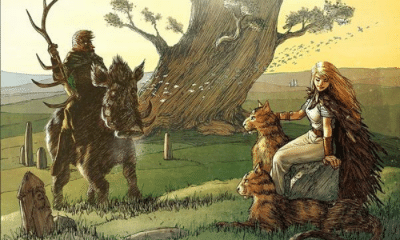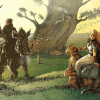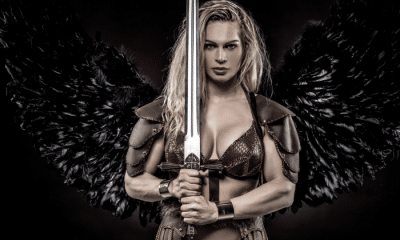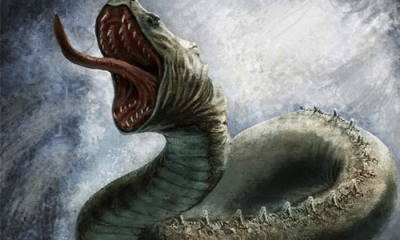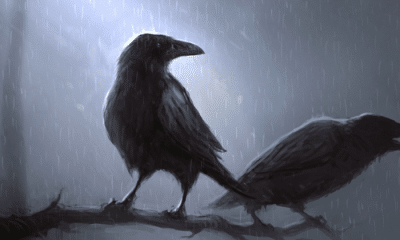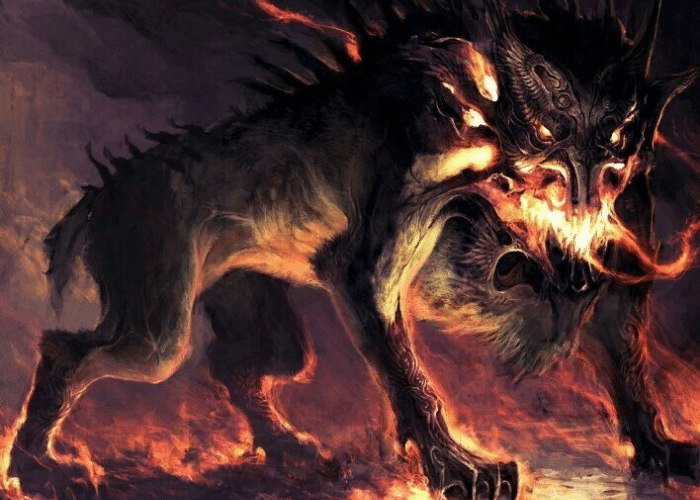
Norse
Garm: Norse Mythology’s Hellhound
Garm: Norse Mythology’s Hellhound
Garm was, quite literally, the hound of Hel. But what do historians have to say about the great dog that guarded the entrance to the Norse Underworld?
The image of the dog at the gates of the Underworld is so often seen in mythology that it has a name: the Hellhound. One of the foremost examples of this theme is the bloodstained beast that watches over the entrance to the realm that gave us that name.
Garm, or Garmr, was the hound who watched the entrance into Hel. Belonging to the evil goddess by the same name, Hel was the most realm of the Norse afterlife.
The hound of Hel would break loose at Ragnarok, along with many other bound and imprisoned monsters, to ravage the world of men. He and Tyr would kill each other in battle.
The familiarity of this theme, however, is part of what makes historians think that Garm might not have been the original Hellhound at all.
Several aspects of the dog and his mythology lead scholars to believe that Garm was a later addition to Norse mythology and the story of Ragnarok. He fits the theme of the Hellhound so well not because he was the first, but because he was based on other myths.
Garm and the Realm of Hel
In Norse mythology, Garm is a great bloodstained hound who lives at the entrance to Hel.
He is usually described as being chained inside his cave, Gnipahellir. In an account of Odin’s journey into the Underworld, the hound pulls at his chains and howls when the god passes by and enters into Hel’s realm.
The Poetic Edda describes him as being the greatest of all hounds, just as Yggdrasil is the greatest tree and the Bifrost is the greatest bridge. His size, strength, and ferocity were legendary.
It is probably because of those features that Garm is often depicted as a wolf. The Norse poets, however, described him as a hunting or guard dog.
The surviving myths do not give an origin for the hound or explain why he is chained in Gnipahellir. Unlike other great monsters, the story of his birth and binding is not told.
He is closely linked to one of the monstrous creatures who is spoken of in more detail, however. Hel, the skeletal goddess of death, was one of the children of Loki who was cast away by the gods to prevent the coming of Ragnarok.
Both Hel and her hound, however, would play an important role in the final battle of the gods.
According to the Poetic Edda, one of the signs of Ragnarok’s start will be the howling of Garm. He will break his chains and, for the first time, leave Hel’s realm and enter Midgard.
The Prose Edda goes on to create a more definite role for the hellhound at the end of the world.
In the matchups between the gods and their foes, Tyr will fight Garm. They will kill one another, both dying in the great battle of Ragnarok.
My Modern Interpretation
Historians have interpreted Garm in a variety of ways. All point to the idea that he was a later addition to the story.
One of the first clues to this is that he is not a unique character, either in Norse mythology or in Indo-European religion as a whole.
He has often been compared to Cerberus, the three-headed dog that guarded the realm of Hades in Greek mythology.
While the association with dogs and the Underworld was not unique to Greece, historians have seen the parallel as a possible sign of later influence. There are other known instances of Norse writers having been influenced by the popularity of Greco-Roman mythology in their eras.
Garm also fits within a widely-used archetype in Norse mythology itself. He is one of many creatures that fits into the chained monster trope.
Fenrir, Nidhogg, and even Loki were enemies of the gods who were chained to prevent them from being a threat to Midgard. Although not chained, the banishments of Hel and Jormundgand also fit this archetype.
Garm, however, does not have the same type of narrative surrounding his imprisonment as these other monsters. Although he is described as bloody, there is no story that says why the gods thought he was enough of a threat to chain him in a distant cave.
Some historians believe that this is because an original story did not exist. Garm was described as chained because the trope was so well established by the time he entered the mythology that it was expected.
One of the most widely-held theories is that Garm was inserted into the narrative as a substitute for Fenrir.
Many wolves and hounds appear in the later descriptions of Ragnarok. While Fenrir is the greatest of them, Garm appears to fight Tyr, Skoll swallows the sun, and Hati destroys the moon.
Some historians have posed the idea that all of these canines were originally one and the same. Instead of many wolves attacking as Ragnarok began, Fenrir alone was responsible for all of the destruction they wrought.
The creatures were probably differentiated to make the story more interesting and more believable. While it would seem unlikely that one monster, however strong, could be responsible for so much, multiple hounds could accomplish the more minor jobs.
The separation of the wolf into multiple creatures also allowed the story to be told in more detail. Each of the gods who died at Ragnarok could be given a different enemy to fight, making the scene more dynamic and exciting.
This theory is supported by the fact that many historians also believe Surt and the army of fire giants were a later addition to the story, as well, that was based on Christian motifs. In the original story of Ragnarok, the gods faced only Loki and his children.
Throughout Norse mythology, Loki and his offspring are framed as the antagonists of the gods. Their role in Ragnarok is alluded to many times and features in many stories, while monsters like Garm and Surt do have as much of a role.
This foreshadowing has given historians further reason to believe that Garm was once depicted as Fenrir.
Tyr’s most famous story involves Fenrir. To bind the great wolf, he sacrificed his hand.
It would make sense, therefore, for Tyr to fight Fenrir at Ragnarok. This would mirror the battle between Thor and Jormungandr, which is foreshadowed in an early interaction between them.
Instead, the Prose Edda says that Tyr falls in a fight against Garm, a hound he has no personal connection with and is not shown as presenting a real threat before Ragnarok begins.
Garm was, therefore, likely written into the mythology at a later date. Inspired by Greco-Roman influences and made to fit the bound monster motif, the hound was envisioned as a separate character to take on part of Fenrir’s oversized role at Ragnarok.
In Summary
Garm was the Hellhound of Norse mythology. Described as a huge, bloodstained dog, he was chained in a cave at the entrance to the realm of Hel.
At Ragnarok, it was believed that Garm would break free of his chains and run free. He would join the final battle, where he and Tyr would die fighting one another.
Many parts of the story have led historians to believe, however, that Garm was a later addition to the Norse legends.
The Hellhound archetype did not originate in Germanic religions, but with the Greeks. Greco-Roman influence could have introduced the idea of the dog at the entrance to the Underworld to Norse writers, particularly later authors who would have been familiar with Latin.
The chained monster is also a well-known trope in Norse mythology. Garm is one of at least half a dozen such creatures who will break out of bindings or imprisonment at the end of the world.
One of these monsters is Fenrir, one of the children of Loki at the center of the Ragnarok story. Unlike Garm, Fenrir’s story includes his origins, a detailed description of his binding, and a personal connection to the gods he fights.
Most notably, Fenrir has a strong connection to Tyr. While it is Garm who fights the one-handed god, Fenrir is the monster that is established as Tyr’s enemy when he bites off his hand.
It seems likely that Garm was one of several creatures added into the story of Ragnarok by post-Viking Age writers. The actions attributed to these hounds and wolves were all originally attributed to Fenrir, but diversified to make the story more dramatic.


